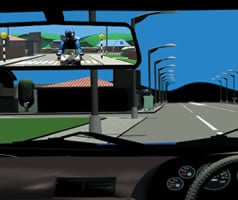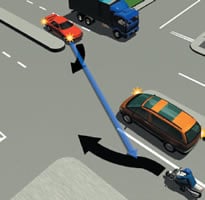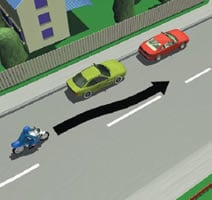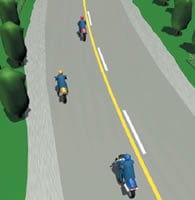Your visibility comes from the clothes you wear while riding, the lights on your bike, and the position your put your motorbike in on the road. Your position won’t stay static: you will change where you are riding on the road in response to other road users, intersections, obstacles and markings on the road, and the direction and camber of the road.
When you are riding you should always assume that other vehicles can’t see you, and position your motorbike where you will be the most visible. The major cause of motorcycle crashes at intersection is a vehicle making a turn across a motorcycle’s path or pulling out from a side street.
If another vehicle can enter your path, such as by changing lanes or turning out of an intersection, you should assume that it has not seen you can could enter your path.
Riding during the daytime
When riding during the daytime you must always ride with your headlight on dip. You can wear high visibility clothing and use your horn to warn drivers who may not have seen you. Adjust your position in the road to anticipate where other vehicles’ blind spots are, and avoid them.
Riding during nighttime
Use your high beam (except in fog, when you are following another vehicle, and when other vehicles are coming towards you), sit upright, and use other vehicles’ tail lights to help you anticipate corners and bumps in the road.
Following another vehicle – avoid blind spots
If you’re following a vehicle where is the best place on the road to position your motorcycle whilst riding?
Riding in a position behind the right-hand wheels of the vehicle ahead (at the correct following distance), you are more easily seen in the rear-vision mirrors of the vehicle in front and are therefore more likely to be noticed. This right wheel-track position also allows you to be seen by oncoming vehicles, and for you to see them.

Following trucks
If the driver of a vehicle immediately ahead of you cannot see you in either the rear view mirrors or by turning their head you are in their blind spot. Trucks and large vehicles have more and bigger blind spots than cars and other motorbikes. Anticipate where other drivers’ blind spots are and avoid driving in them. For trucks, staying back and ensuring your can see the vehicle’s side mirror means that the driver can also see you.
Giving unambiguous signals
Be clear about exactly what your intentions are by using your signals and positioning. If you forget to cancel your indicator it could cause another vehicle to pull into your path if they think you are turning.
When you are about to overtake or turn, adopt a position that lets other road users know your intentions.
Positioning for maximum visibility
 What should you do if an oncoming vehicle seems ready to cross your path?
What should you do if an oncoming vehicle seems ready to cross your path?
You should slow down and move to the left of your lane. Take extra care if there are stationary vehicles blocking the driver’s line of vision. Sound your horn if necessary.
When in a line of stopped or moving traffic protect your lane position from other vehicles and be as visible as possible by staying in the middle of your lane unless you need to move left or right to make yourself more visible. Don’t squeeze by other traffic as this increases the risk of an accident.
If another driver is following you too closely and you are in a line of traffic, drop back to give yourself more a buffer for braking. If you are on the open road, move left and let them past, unless it compromises other road users’ visibility of you.
If you see a vehicle ahead of you about to pull out of a parking space or do a u-turn you should slow down and move to the right of the lane. This gives the other driver more time to see you, and you more time to react.
Passing parked vehicles
 When passing parked vehicles, in what position in the lane should you be?
When passing parked vehicles, in what position in the lane should you be?
Being on the right gives you more room to react if a car pulls in front of you, and also removes the chance of a car driver opening a door into your path, which could happen if you are riding close to the vehicles.
When passing parked vehicles, a motorcyclist has an advantage over drivers because, by staying in the right-hand part of the lane, s/he can avoid problems caused by doors opening, drivers getting out of other vehicles or people stepping out from between vehicles.
Riding in groups
Beginner riders should be placed at the front of a group so that more experienced riders can watch out for them. This also means that they won’t feel pressured to ride beyond their abilities if other riders in the group can ride faster and start leaving them behind.
Riders should ride in a staggered formation, as shown below. This means that the second rider’s view is less obstructed by the first rider, and the third rider’s view is less obstructed by the second rider, and so on.

Positioning for curves
If you are a learner rider, slow down before going through curves. New motorcycle riders often enter turns too quickly. This means they can’t hold the turn and they tend to cross into another lane of traffic or go off the road, or they brake too hard and skid out of control. Slowing down is the best plan.
If the road has a high crown (centre) there will be less clearance between your right peg and the road as you turn right and this means you could catch your peg on the road more easily. The downslope also makes the turn more difficult.
If you do get your curve approach wrong and need to brake in the curve, use both brakes gently. You should try to avoid having to slow in a curve – always brake on the straight before it’s too late.
Note that some motorcycle instructors advise you to only use the rear brake in this situation, which contradicts NZTA’s information.
Crosswinds and slipstreams
If you meet an oncoming heavy vehicle the pressure front at the front of the vehicle will push you away, but the slipstream behind it will suck you towards it. The closer you are to the centre line, the more you will feel this effect.
If you are following a large vehicle you might feel yourself being pulled along in its slipstream. Within the slipstream there is less air resistance – you won’t feel as much wind buffeting or wind chill. At the edge of the slipstream there will be more turbulence.
Crosswinds
Buildings can shelter you from cross winds. As you emerge from the protection of a building you can be hit suddenly by a cross wind, which can throw you off your balance.

